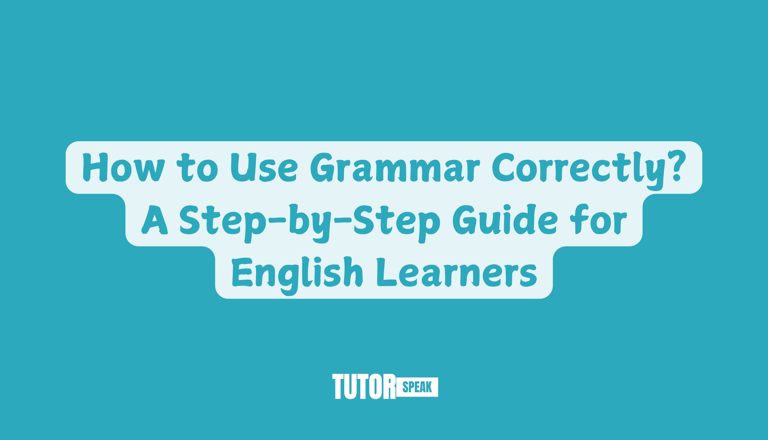How to Use Grammar Correctly | Grammar Rules for English Learners
Learn how to use grammar correctly with this 1000+ word guide. Includes rules, examples, and practical tips for beginners and intermediate English learners.
TutorSpeak
2 min read


How to Use Grammar Correctly: A Step-by-Step Guide for English Learners
Good grammar is the foundation of clear and effective communication. Whether you're writing emails, taking exams, or having conversations, knowing how to use grammar correctly helps you express yourself confidently and avoid misunderstandings. This article will guide you through the most important grammar rules and give you practical strategies to improve your grammar step by step.
1. What Is Grammar and Why Is It Important?
Grammar is the system and structure of a language. It includes rules about how words combine to form phrases and sentences. Grammar matters because it:
Helps you communicate clearly
Builds credibility and professionalism
Supports writing and speaking fluency
Reduces confusion in conversation
2. Learn the Parts of Speech
The first step to using grammar correctly is understanding the 8 basic parts of speech:
Nouns (e.g., book, idea, teacher)
Pronouns (e.g., he, she, it)
Verbs (e.g., run, be, have)
Adjectives (e.g., big, fast, beautiful)
Adverbs (e.g., quickly, very, often)
Prepositions (e.g., in, at, on)
Conjunctions (e.g., and, but, because)
Interjections (e.g., wow, oh, ouch)
Knowing how each part functions in a sentence helps you build grammatically correct sentences.
3. Master Sentence Structure
A correct sentence usually follows this pattern: Subject + Verb + Object
Example: She (subject) eats (verb) an apple (object).
Other sentence types include compound and complex sentences. For example:
Compound: She eats an apple, and he drinks coffee.
Complex: Because she was hungry, she ate an apple.
Using a variety of sentence structures makes your writing more interesting and natural.
4. Use Correct Verb Tenses
Tenses show when an action happens. The three main categories are:
Past (e.g., walked, was, had)
Present (e.g., walk, is, have)
Future (e.g., will walk, is going to be)
Common mistake: mixing tenses in the same sentence.
Incorrect: She eats dinner and went to bed. Correct: She ate dinner and went to bed.
Understanding how to use tenses properly is key to using grammar correctly.
5. Pay Attention to Subject-Verb Agreement
The verb must match the subject in number (singular/plural).
Correct: He walks to school. / They walk to school. Incorrect: He walk to school.
This rule is simple but essential in speaking and writing correctly.
6. Use Articles Properly
Articles (a, an, the) are often difficult for learners.
Use "a" before words that start with a consonant sound (a book).
Use "an" before words that start with a vowel sound (an apple).
Use "the" when referring to something specific (the car we bought).
7. Avoid Common Grammar Mistakes
Here are some of the most frequent grammar mistakes and how to avoid them:
Their/There/They’re: Learn the difference.
Its/It’s: "It’s" means "it is"; "its" is possessive.
Too/To/Two: Know when to use each.
Double negatives: Don’t use two negatives together (e.g., "I don’t know nothing").
8. Use Punctuation Correctly
Punctuation marks help clarify meaning. Key ones include:
Periods (.) to end sentences
Commas (,) to separate items or clauses
Question marks (?) for questions
Exclamation points (!) for strong emotion
Incorrect punctuation can lead to confusion. Compare:
Let’s eat, grandma! (correct)
Let’s eat grandma! (incorrect—and scary!)
9. Practice Makes Perfect
The best way to use grammar correctly is to practice:
Read English daily (books, blogs, articles)
Write short texts and ask someone to check them
Take online grammar quizzes
Use grammar apps like Grammarly or QuillBot
10. Get Feedback and Learn from Mistakes
Ask a teacher, tutor, or native speaker to correct your grammar. Feedback helps you:
Spot patterns in your mistakes
Understand confusing rules
Gain confidence in using correct grammar
Keep a grammar notebook and review it weekly to track your progress.
Conclusion
Learning how to use grammar correctly takes time, but it’s worth the effort. Start with the basics, build good habits, and practice regularly. As you apply the tips in this guide, you’ll write and speak more clearly, accurately, and confidently.



